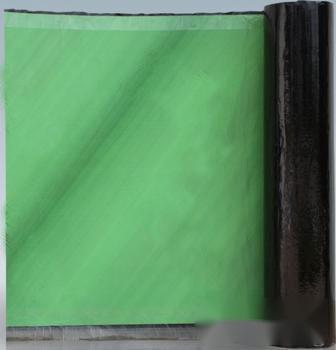1. Product Introduction
The non-asphalt-based reactive pre-applied polymer self-adhesive waterproof membrane is specially developed for underground and tunnel engineering. It can form a firm anti-adhesion waterproof membrane with the subsequently poured concrete structure. This membrane is primarily made of resin-based polymers (such as EVA, LDPE, HDPE, ECB, etc.) as the main waterproof material, with a self-adhesive membrane overlaying the polymer waterproof substrate. The self-adhesive layer and the environmental protection layer have self-healing properties. After reacting and solidifying with the liquid concrete slurry, it forms a seamless bond between the waterproof layer and the concrete structure, eliminating the risk of water intrusion and effectively enhancing the reliability of the waterproof system.
2. Product Features
1. Unique formulation: The non-asphalt-based reactive pre-applied polymer self-adhesive waterproof membrane is composed of non-asphalt-based self-adhesive material and polymer sheets.
2. Unique bonding performance: The peel strength is 2-3 times that of ordinary self-adhesive membranes.
3. High tear resistance, waterproof and anti-permeability, strong hydrolysis resistance.
4. Good low-temperature flexibility, maintaining good flexibility even at -30℃.
5. Suitable for pre-applied anti-adhesion waterproof projects in underground and tunnel engineering, with impact resistance that allows direct binding of rebar and pouring of concrete without the need for a protective layer after the waterproof layer is completed.
6. Reliable waterproof performance, combining the advantages of polymer waterproof membranes and self-adhesive membranes.
7. Low substrate requirements, saving construction time. There is no need for cement-sand leveling of the base layer, and it can be constructed on damp surfaces; no treatment of the bottom layer or base layer is required, unaffected by weather conditions, thus saving construction time and reducing project costs.
8. Simple and fast construction with flexible and diverse methods. Wide membranes can be produced according to actual needs, resulting in less overlap, fast construction, low consumption, and low cost; construction methods such as air laying and mechanical fixing can be selected based on site conditions, making construction more flexible and waterproofing more effective.
9. Green, environmentally friendly, and safe. No solvents or fuels are required during construction, avoiding environmental pollution and fire hazards, while saving energy.
10. The waterproof membrane is laid on the substrate without being affected by substrate settlement or deformation.
3. Application Scope
1. Transportation engineering: Waterproof and anti-permeability projects for subways, tunnels, caverns, bridges, etc.
2. Construction engineering: Waterproof projects for roofs, basements, etc.
3. Water conservancy projects: Waterproof and anti-permeability projects for reservoirs, embankments, cofferdams, canals, artificial lakes, etc.
4. Environmental protection projects: Waterproof and anti-permeability projects for landfills, sewage treatment plants, metallurgy, chemical plants, etc.
The non-asphalt-based reactive pre-applied polymer self-adhesive waterproof membrane complies with the standard: GB/T23457-2009 "Pre-applied/Wet-applied Waterproof Membrane" in the pre-applied P category.
4. Construction Method
1. Membrane laying: Unroll the membrane with the polymer substrate facing the ground or wall, ensuring that the end overlapping areas are staggered.
2. Longitudinal overlap of the membrane should be 70mm, and transverse overlap should be 100mm. Remove the isolation film from the overlapping edge of the membrane, and then roll the overlapping areas firmly.
3. Fixing the vertical membrane: During vertical installation, mechanically fix the membrane at intervals of 300-400mm (or as determined by design specifications and the height of the membrane installation) within 20-30mm from the edge of the previous roll, using steel nails with sealing washers. The mechanical fixing points will be covered by the next roll's overlap, ensuring complete seal coverage.
5. Precautions
Construction is strictly prohibited in rainy, snowy weather, and when wind speeds exceed level 5 (excluding construction within tunnels and caverns). The environmental temperature for adhering the self-adhesive membrane should not be lower than 5℃.
Different types and specifications of products should be stored separately and not mixed during transportation and storage.
The temperature should not exceed 45℃, and the stacking height of the membrane during storage should not exceed five layers.
Prevent tilting or pressure during transportation, and cover with tarpaulin if necessary.
Under normal transportation and storage conditions, the product's storage period is at least one year from the date of production.













